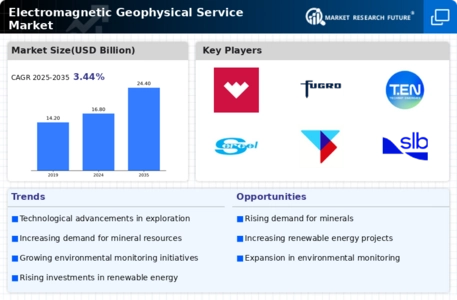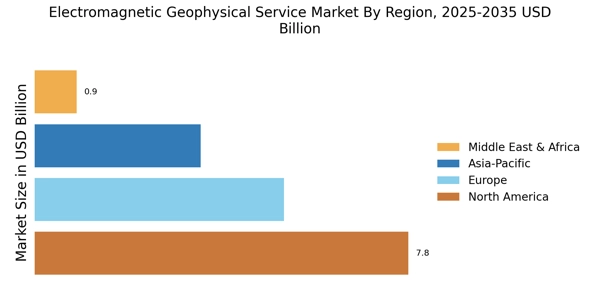Technological Advancements
The Electromagnetic Geophysical Service Market is experiencing a surge in technological advancements that enhance data acquisition and interpretation. Innovations such as improved sensor technology and advanced data processing algorithms are enabling more accurate subsurface imaging. This is particularly relevant in sectors like oil and gas exploration, where precise geological mapping is crucial. The integration of artificial intelligence and machine learning into electromagnetic surveys is also streamlining operations, potentially reducing costs and time. As a result, the market is projected to grow, with estimates suggesting a compound annual growth rate of around 6% over the next five years. These advancements not only improve efficiency but also expand the applicability of electromagnetic services across various industries.
Expansion of Infrastructure Development
The Electromagnetic Geophysical Service Market is poised for growth due to the expansion of infrastructure development projects. As urbanization accelerates, there is a pressing need for reliable geophysical data to inform construction and development decisions. Electromagnetic methods are particularly useful in urban settings for detecting utilities and assessing ground conditions. The market data indicates that infrastructure investments are expected to increase, particularly in developing regions, which may drive demand for electromagnetic geophysical services. This trend suggests that service providers will play a crucial role in supporting infrastructure projects, thereby contributing to the overall growth of the market.
Increased Demand for Mineral Exploration
The Electromagnetic Geophysical Service Market is witnessing heightened demand for mineral exploration, driven by the need for sustainable resource management. As countries strive to secure their mineral resources, the use of electromagnetic methods for exploration has become increasingly vital. These methods allow for non-invasive assessments of subsurface conditions, which is particularly appealing in environmentally sensitive areas. The market data indicates that the demand for minerals such as lithium and rare earth elements is on the rise, further propelling the need for effective exploration techniques. This trend suggests that the electromagnetic geophysical services will play a pivotal role in meeting the growing global demand for minerals, thereby fostering market growth.
Growing Interest in Renewable Energy Sources
The Electromagnetic Geophysical Service Market is increasingly influenced by the growing interest in renewable energy sources. As nations transition towards sustainable energy solutions, the need for effective site characterization for renewable energy projects, such as wind and solar farms, becomes paramount. Electromagnetic methods can provide critical information about subsurface conditions, aiding in the optimal placement of energy infrastructure. The market is likely to see a rise in demand for these services as investments in renewable energy continue to expand. Data suggests that the renewable energy sector is projected to grow significantly, which may lead to increased utilization of electromagnetic geophysical services for site assessments and feasibility studies.
Regulatory Support for Environmental Assessments
The Electromagnetic Geophysical Service Market benefits from increasing regulatory support for environmental assessments. Governments are implementing stricter regulations regarding environmental impact assessments, which necessitate the use of advanced geophysical methods. Electromagnetic techniques are particularly effective in identifying contamination and assessing subsurface conditions without disturbing the environment. This regulatory landscape is likely to drive demand for electromagnetic services, as companies seek to comply with environmental standards. Market data indicates that investments in environmental monitoring and assessment are expected to rise, creating opportunities for service providers in the electromagnetic geophysical sector. This trend underscores the importance of integrating geophysical services into environmental management practices.


















Leave a Comment